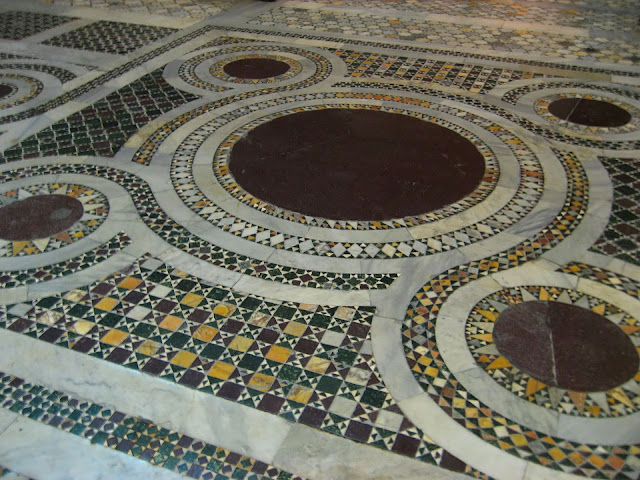Anyone who follows liturgical and ecclesiastical arts will invariably, at some point, come across the term "cosmatesque," but to what does this refer? Cosmatesque is also referred to as "Cosmati" which is actually a family name. The Cosmati family were a Roman family who, for at least four generations during the twelfth and thirteenth centuries, practiced their craft. What was their craft? The creation of decorative, geometric mosaics that could be seen on everything from -- especially -- church floors -- to objects of liturgical art such as ambos, balustrades, columns and so on. The technique is a form of what is called "opus sectile" work which simply means "cut work" in which coloured stone and glass was cut into geometric shapes and inlayed together to form intricate patterns. So then, the term "cosmatesque" simply means that it was done in the style of the Cosmati family and should you walk into many of the churches in Rome in particular, it is one of the most striking features you will frequently see within them. The floors in particular are attention grabbing -- which is quite a feat when you think about it, given the amount of ornamentation found in your typical Roman church above the floor level. Of course it should be noted that cosmatesque work can be found outside of Rome, but it is within Italy and Rome in particular that one can find a particularly high concentration of this form of medieval decorative work.
So with that background in mind, let's take a look at a few examples of this genre of liturgical art. One of the very best places to look at it, in my opinion, is the basilica of San Clemente in Rome. This church is, on the interior, a particularly fine, in tact example of medieval Romanesque, and in that regard you get to see this form of ornament within its proper historical context.
.jpg) |
| (Source) |
Another view, this time from basilica of Santa Prassede:
To get the full effect however, one has to look at this work both from a distance as well as an in detail. Below are some details of the cosmatesque floor of Santa Maria Maggiore will give you a better sense of the opus sectile work that makes up these larger geometric patterns.
 |
| This particular section of the floor also includes a beautiful central disc of red porphyry. |
Another detail, this time from the pavements of Santa Croce in Gerusalemme:
As noted, while cosmatesque floor designs are of particular note, this type of decorative schene is not exclusive to floors. Here for example are some cosmatesque decorations as seen in the cloisters of the Basilica of St. Paul Outside the Walls.
Likewise on the columns, such as this seen in Santa Maria in Trastevere:
The ambo of the basilica of St. Lawrence Outside the Walls in Rome:
Perhaps most famously, the pope's cathedra of the Lateran archbasilica:
Even altars can be found with this form of decoration, such as this altar found in the crypt of San Prassede in Rome:
Basically, if you could ornament it, you can likely find it in the Cosmati style, especially in Rome.
It should be noted that very frequently these coloured stones came from ancient Roman 'spoila' which were cut down and repurposed for this new decorative usage. It is also worth noting that the designs were not strictly geometric abstractions; medievals loved their symbols and symbolism and many of these designs tied into Christian themes and symbols.
We may take a deeper look into this at some point in a future article, but for now we will suffice to leave things at this very brief introduction.




















